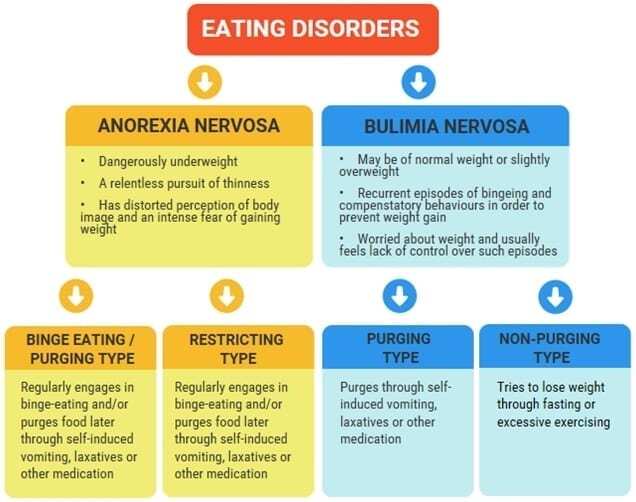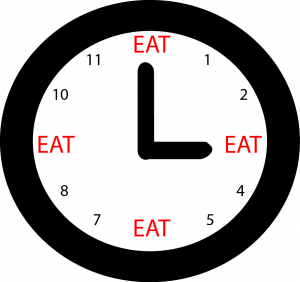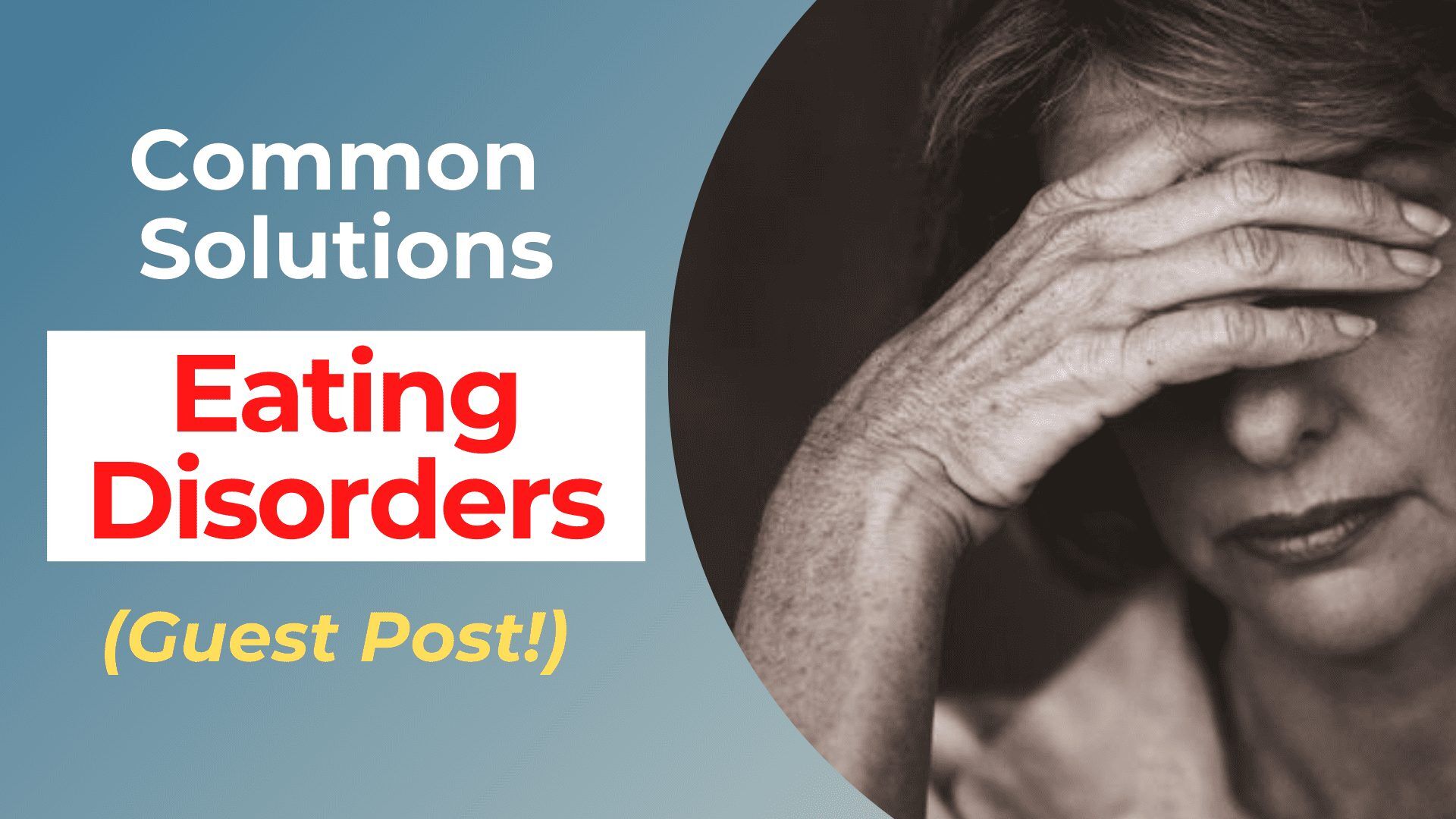Are you wondering about common solutions to eating disorders?
Eating disorders are a serious issue that many people struggle with.
There are many different types, each of which has its own specific solutions and treatment methods.
But! There are commonalities between these solutions to eating disorders, which apply to all types of eating disorders.
The solutions in this blog post will help you understand more about these commonalities.
(Please note: this is a guest post by author Josiane Camilleri, a professor of psychology at the University of Malta. For more info see at the bottom of this post!)
What are the different types of eating disorders?

Along with other psychological disorders, ranging from anxiety to depression, there is an eating disorder range too.
Eating disorders damage physical health, but that’s not the worst of it. An eating disorder will have profound psychological effects, severely damaging human self-esteem and self-worth.
This is why eating disorder treatment is so necessary. But before talking about eating disorder treatment, let’s understand what exactly an eating disorder is first.
Experts have described eating disorders:
“Persistent disturbance of eating or eating-related behavior that results in the altered consumption or absorption of food that significantly impairs physical health or psychological functioning.“
Here is an overview of the different types of eating disorders.
1 – Anorexia Nervosa:

The eating disorder “Anorexia nervosa” is characterized by self-starvation due to intense fear of weight gain and becoming fat. This results in drastic and severe weight loss. These people have distorted self-images about their body image and shape.
Their body mass index (BMI) is typically under 18.5 in adults. It is primarily diagnosed in adolescent women and young girls and boys.
Sadly, anorexia nervosa is the most fatal of eating disorders. Why? Anorexic people suffer from medical complications which may lead to death, such as:
- heart problems
- kidney failure
- electrolyte imbalance
This is all because anorexic people view themselves as horribly overweight. Even when they can see their own ribs sticking out!
Their distorted body image drives them to restrict their food intake to completely disregard their body’s healthy weight, along with devastating mental health conditions.
2 – Bulimia Nervosa:

The eating disorder called “Bulimia nervosa” is characterized by:
- Recurrent episodes of binge-eating
- Inappropriate compensatory behaviors like purging to prevent weight gain
- Self-evaluation unduly based on body image and shape
Hence, people with Bulimia nervosa feed on low calories and binge-eat on high calorie. This means eating large amounts of high-calorie food in a shorter period.
They then show inappropriate compensatory through vomiting, excessive exercise, fasting, etc. laxative misuse.
These behaviors impact their psychological well-being negatively and lessen self-worth and self-esteem.
When a bulimic person purges (aka, vomits) their brain releases a large amount of dopamine.
Thus, a person becomes addicted to the ‘high’ of purging. Even while purging is stripping their body of vital nutrients!
3 – Binge-eating disorder (BED):

The eating disorder called “Binge eating disorder” is characterized by binge eating. Unlike bulimia nervosa, this disorder is not associated with frequent compensatory behaviors.
But, binge-eating is chronic to health, leading to cardiovascular disorders, obesity, hypertension.
Oftentimes binge eaters wolf down food when they become triggered. A trigger can be anything from anger to sadness to boredom.
Unlike anorexia nervosa, binge-eating disorder is not as commonly diagnosed in adolescents.
Rather it is more common in adults who are obese or have struggled with weight problems for many years.
4 – Avoidant Restrictive Food intake:
The eating disorder called “Avoidant restrictive food intake” involves a disturbance in eating and picky eating patterns. This leads to loss of appetite and low nutrition.
People with this eating disorder pick food based on smell, vision, and texture and fail to fulfill their nutritional requirements.
They are overly concerned about nutrition, and eating perfectly healthy.
The anxiety of eating in this kind of eating disorder causes:
- vomiting
- constipation
- nausea
- choking
5. Pica:
The eating disorder called “Pica” is characterized by intake of non-nutritious and non-food substances for at least one month.
Typically, ingested substances include paper, paint, rubber, chalk, pebbles, clay, etc.
It also leads to severe clinical conditions. It occurs from childhood to adolescence to adulthood.
6. Rumination disorder:
The eating disorder called “Rumination disorder” is characterized by repeated regurgitation and rechewing of food for no clear reason like nausea, disgust, etc.
In this case, the person brings back swallowed food in their mouth. They rechew it, and re-swallow and then spits it out. It also occurs from infancy to adulthood due to intellectual disability.
Despite the different eating disorders, there are similarities in how you treat them!
What are some common solutions to eating disorders of all types?
To recap, eating disorders are dangerous for both physical and mental health.
They put people at the risk of various chronic diseases like:
- cardiovascular and intestinal disease
- kidney failure
- malnutrition
- low self-esteem
- anxiety
- depression
- social isolation
- risk of suicide.
To prevent and facilitate eating disorder treatment, here are some of the tips:
1 – Awareness and knowledge:
First of all, you must to have awareness and knowledge of these eating disorders.
They say eating disorder awareness is half the battle, and boy is it an important first step!
By far the two most common responses to eating disorders are:
- ignorance
- denial
Ignorance is where people don’t know about an eating disorder.
Someone living in ignorance may exhibit eating disorder symptoms without realizing it.
For example, a person who is ignorant may not realize they have anorexia nervosa. They may continue trying to lose weight even though they are already very thin.
Because anorexia is often reinforced by culture and social media, a person will often need to visit an eating disorder treatment facility to regain a healthy weight.
Denial is where people don’t admit they a problem because of their old habits, delusions or ideas.
For example, many parents may deny that there’s anything wrong with their child who lost 40 pounds in just two months, obsesses everyday in front of the mirror about their appearance and has almost no social contact!
Obviously, if you are in denial or ignorant over such behavior then it’s impossible to treat eating disorders!
Thus awareness and knowledge about eating disorders become a necessary first step to combat this mental illness!
2 – Adjust the attitude:

Secondly, it’s imperative to adjust your attitude about body size, shape, and image.
A key part of adjusting attitude around body image is realizing a person’s weight does not reflect health.
For example, you can be thin and still have diabetes or hypertension!
In fact, many people with eating disorders are of normal bodyweight!
This is because the key factor that determines whether someone has an eating disorder or not isn’t how much they weigh. But rather what the thoughts and behaviors around food control them.
It helps to realize that your immediate judgment about others by looking at their appearance could actually be wrong!
For instance: don’t think because somebody is skinny she/he doesn’t eat junk foods.
You can also:
- Avoid any body shaming and judgments based on body type.
- Discourage the happiness associated with physical looks
- Look for more fundamental things in others and within you.
- Challenge the beliefs and myths associated with particular body types.
Altering beliefs are helpful not for others but to avoid any such disorder at a personal level.
A great way to alter and challenge beliefs is through Cognitive Behavioral Therapy. For more info on Cognitive Behavioral Therapy, please see my article here.
3 – Encourage excellent and healthy eating:

It’s vital to encourage healthy eating to succeed in treating eating disorders.
Healthy eating means:
- eating enough food at regular times throughout the day
- so your body has enough energy to function and feel well.
Of course, in today there is so much misinformation out there!
There are so many fad diets that people have been tricked into believing unhealthy habits are actually healthy eating behaviors!! These fad diets seem healthy when in fact they can cause so much more harm than good!
We need to dispel the myth by encouraging a nutritious, balanced diet!
Also, you can encourage children against skipping meals or fasting for long periods of time. These skipping habits are going to mess up their internal clocks. Eventually it could lead them towards an eating disorder.
Here are some other great tips too!
- Recognize hunger, eat healthy food.
- Encourage others to do the same rather than stay hungry.
- Eat a variety of food and make all kinds of the food part of your diet to keep it balanced.
- Develop a taste for everything, and enjoy the meal.
- Discourage and avoid making comments on food and promote eating healthy food.
- Educate about damages associated with poor eating patterns and eating disorders.
4 – Start the eating disorder treatment conversation:
It’s crucial to start a conversation about treatment for eating disorders with the people at potential risk.
But, of course, we have to account for ignorance and denial. We can’t just plunge into suggesting treatments for eating disorders or which mental health professional they should visit!
Remember, ignorance and denial are our biggest challenges to overcome!
Many people firmly believe their restrictive way of eating is actually beneficial to their health.
For example, people with anorexia generally have a distorted image of their own body. They think they’re overweight when they are actually very thin.
They think starving themselves and engaging in other disordered eating habits is a good thing! Even when they can no longer function, do the things they love, and have no friends – they still believe in their starvation!
This is why it’s so important to talk openly about eating disorders.
Be respectful in the way that you approach someone with these thoughts or behaviors.
A good way to start this conversation is by simply asking if they’re okay and whether you can help.
If the person doesn’t respond well, don’t take it personally! They might be afraid of their disorder being found out.
We may also find people who are already struggling but haven’t yet reached out for help. This means we have an opportunity here to assist them by encouraging them towards treatment options like therapy, counseling, support groups etc…
The key point here is:
Start a conversation about eating disorders so more people know more about these harmful behaviors!
Common solutions to eating disorder conclusion
These few tips can help in putting an end to eating disorders in everyday life.
We need to recognize eating disorders are behavioral and psychological.
In the end, people need counseling and change of stance towards body image and healthy living.
Only this awareness and change can bring these disorders to an end through a recovery process.



My favorite part of this article is anorexics experience medical issues that can lead to death. Someone recently told me about this and it is different from what I understand. Thanks for helping me understand treatment options for eating disorders.
Thanks Jeff for your comment, I hear you and think similarly
This post is very easy to read and understand without leaving any details out. Great work! Thanks for sharing this valuable and helpful article.
Thanks James! I appreciate the positive feedback and glad you found some value as well